INTERNATIONAL SCIENTIFIC JOURNAL "SYMBOL OF SCIENCE" No. 01-2 / 2017 ISSN 2410-700X_
Salavatov Salavat Yulaevich
4th year student, BashSU G. Ufa, RF E-mail - [email protected]
GEOLOGICAL CHARACTERISTICS OF THE PRIRAZLOMNOE OIL FIELD
annotation
This article briefly describes the geological component of the shelf Prirazlomnoye field. The relevance of the topic is due to the fact that the field is currently the only project in Russia for the production of hydrocarbons on the Arctic shelf.
Key words Field, shelf, reservoir, reservoir, horizon.
Prirazlomnoye is a unique field of its kind for Russia, located beyond the Arctic Circle in the Pechersk Sea. This is the only field on the Russian Arctic shelf where oil production has already begun.
The field is located on the shelf of the Pechora Sea, 55 km north of the Varandey settlement and 320 km north-east of Naryan-Mar (Fig. 1).
Figure 1 - Location of the Prirazlomnoye field on the map
Prirazlomnoye was discovered in 1989 and contains more than 70 million tons of recoverable oil reserves. The new Russian grade oil was named Arctic Oil (ARCO) and was first shipped from Prirazlomnoye in April 2014. Belongs to the Timan-Pechora oil and gas province. The sea depth in the area of the field is 19-20 meters.
The production is carried out on an offshore ice-resistant oil production platform.
Tectonically, the field is located in the southeastern part of the Pechora Sea on the continuation of the Varandey-Adzvinskaya structural zone. Oil deposits are confined to the Carboniferous-Lower Permian deposits. The reservoirs are cavernous-porous reef limestones. In terms of oil and geological zoning, the field belongs to the Timan-Pechora basin.
INTERNATIONAL SCIENTIFIC JOURNAL "SYMBOL OF SCIENCE" No. 01-2 / 2017 ISSN 2410-700X
The productive horizon, exposed by four wells, is represented by two carbonate reservoirs of different genesis. The upper highly porous reservoir, composed of bioclastic limestones, is overlain by clays of the Kungurian stage, forming a regional seal by two thin (1-2 m) and impermeable layers, and is divided into three layers: Ia, Ib, Ic.
The lower reservoir II is represented by relatively dense Carboniferous limestones. It is weakly expressed in the seismic wave field due to low reservoir properties.
Productive formation I correlates well between all wells. Layer! A is distinguished only in the section of borehole no. 3 and 4, located in the central and southeastern parts of the structure, and is represented by interlayering of highly porous and low-porous (to impermeable) limestones. The seam was subjected to palsorization; it is absent in the roof and in the north of the structure (well 1.5). On the east wing in borehole no. 4, only its plantar part is preserved. The greatest thickness of the reservoir is noted in the well. 3. Layers Ib and Ic are spread over the entire field.
The total thickness of the limestones of productive stratum I (according to drilling and seismic data) varies within 43-85 m, effective - 42-85 m, for productive stratum II (according to drilling data), respectively 49.5-63.0 and 11.1- 26.2 m.
Areal inconsistency of the effective thickness of reservoirs of reservoir II with their low porosity (< 10 %) не позволяет рассматривать этот горизонт в качестве самостоятельного объекта разработки.
The main oil reserves are confined to reservoir I, which is widespread in the field and is characterized by average porosity (15.6-21.7%) and permeability (0.05-0.4 μm2). Its average oil saturation is 77-95%.
Features geological structure deposits are:
Structural-tectonic type of reservoir (traps);
Good consistency in the area of the thickness of the main reservoir and its petrophysical properties;
The confinement of increased values of porosity and permeability of reservoirs (and, accordingly, increased concentration of reserves) to the central and southern parts Place of Birth;
Significant development of vertical fracturing, especially in the northern part of the field;
Increase in the ratio of vertical to horizontal permeability from the central to the northern part of the field.
List of used literature:
1. Nikitin BA, Khvedchuk I. I. "Prirazlomnoye oil field on the Arctic shelf of Russia". Geology of oil and gas, No. 2. Moscow 1997
2. Shipilov E. V. "Hydrocarbon deposits of the Russian Arctic shelf: geology and distribution patterns". Vestnik MGTU, volume 3, No. 2, 2000
3.www.neftegaz.ru
© Salavatov S.Yu., 2017
Farkhutdinova Dilara Ramilevna
student of Bashkir State University, Ufa E-mail: [email protected]
OIL INDUSTRY OF RUSSIA Abstract
In terms of proven oil reserves, Russia is one of the leading oil-producing countries in the world. In her
The Prirazlomnoye oil field is located on the shelf in the southeastern part of the Pechora Sea on the continuation of the Varandey-Adzvinskaya structural zone.
The Prirazlomnoye field was discovered in 1989. The field was discovered by Arktikmorneftegazrazvedka during geological exploration for oil and gas on the shelf. Within the field, the sea depth is 17-19 m. The number of drilled wells in the field is five. Four wells (No. 1,2,3,4) were drilled by Arktikmorneftegazrazvedka.
The license for exploration and production of hydrocarbons at the Prirazlomnoye field is held by ZAO Sevmorneftegaz, a 100% subsidiary of OAO Gazprom. The recoverable oil reserves of the Prirazlomnoye field amount to 46.4 million tons, which makes it possible to achieve an annual production level of about 6 million tons.
Importance of project implementation
The development of the hydrocarbon potential of the Arctic shelf is a fundamentally new stage in the development of the fuel and energy complex of Russia in the 21st century. According to forecast estimates, the initial total hydrocarbon resources on the Russian continental shelf amount to about 90 billion tons of fuel equivalent. Of these, more than 60 billion tons of fuel equivalent. t. are concentrated in the Barents and Kara seas... The main part of the shelf resources is gas - 76 trillion. cub. m.
The formation of a new gas production region in Russia on the basis of the deposits of the Arctic Seas shelf and the involvement in the development of oil fields will help to strengthen Gazprom as a diversified energy company of the world level.
The Concept of the company's operation on the Russian shelf, developed by OAO Gazprom, proposes a comprehensive method for the development of fields in the Barents, Kara and Pechora seas. The integrated approach is based on the development of groups of closely located fields, which allows to optimize costs and creates conditions for the joint development of large and relatively small offshore fields.
In this regard, the development of the Prirazlomnoye field is an urgent task for Gazprom, since the infrastructure created for the implementation of the project will become the basis for the subsequent development of hydrocarbon resources in the Barents and Kara Seas.
The trap is an uplift of an asymmetric profile, limited from the southwest by an upthrust. Two oil deposits are confined to carbonate deposits of the Lower Permian-Carboniferous deposits and are massive in type. The reservoirs are cavernous-porous reef limestones. Clay deposits of the Artinsk-Kungurian age serve as a regional seal.
A new word has been said in the field of domestic oil production. The Prirazlomnoye field became the first sign in the development of offshore underground wealth Arctic and Of the Far East... This is a promising solution that will bring great benefits to our country in economically and what is much more valuable, energy independence. However, the Arctic imposes its own restrictions on the exploitation of this field.
Given natural area harsh atmospheric conditions... So, the water surface freezes for 7 months, the ice thickness is about 2 m, the temperature minimum can reach -45 ° C. Oil reserves are located in the most explored part Russian Arctic- on the shelf extension of the Varandey-Adzvinskaya lithospheric plate, where in the early 90s detailed tectonic monitoring was carried out with the drilling of four exploration wells.
Where is
The field is located in the shallow southeastern part Barents Sea at a distance of 320 km northeast 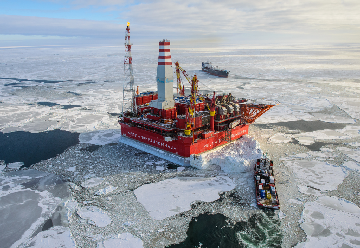 from administrative center Nenets Autonomous Okrug Naryan-Mar and 980 km from Murmansk. It was opened in 1989.
from administrative center Nenets Autonomous Okrug Naryan-Mar and 980 km from Murmansk. It was opened in 1989.
It turned out that the discovered deposits are a branch of the vast Timan-Pechora oil and gas basin, the border of which in the south reaches Perm. Its sedimentary rock consists of Paleozoic and Mesozoic deposits.
At one time, they served as the source material for modern oil and gas formations. The development of continental reserves started in the 18th century (then on Ukhta, oil was discovered on earth surface), however, until the development of the Far North as an oil and gas region, hands reached only two hundred years later.
The main characteristics of the field
 The depth of the Arctic Ocean here does not exceed 19–20 meters, but the capacity of the Prirazlomnoye is estimated at 72 million tons of oil. Its structure looks like a two-domed anticlinal fold with a northwest strike. The presence of small faults (mountain disturbances) accompanying the fold axis is not excluded.
The depth of the Arctic Ocean here does not exceed 19–20 meters, but the capacity of the Prirazlomnoye is estimated at 72 million tons of oil. Its structure looks like a two-domed anticlinal fold with a northwest strike. The presence of small faults (mountain disturbances) accompanying the fold axis is not excluded.
Clays occur in the upper layer, oil-saturated layers are located under them, which are separated by dense, thoroughbred partitions. The deposit contains high quality raw materials... The mineral contains a small amount of sulfur, has good characteristics in terms of density and viscosity, according to the analysis results, resembling the Urals grade.
The new grade was named ARCO (ArcticOil) Arctic oil.
Based on the concept of the company on the shelf, adopted by Gazprom, it is planned to jointly develop the Prirazlomnoye and Dolginskoye oil fields. This step is an integral part of the strategy for the integrated development of the Barents, Karsky and Sea of Okhotsk... Its essence lies in the development of a number of deposits located close to each other.
This approach will make it possible to reduce costs, as well as prepare the prerequisites for the systematic development of offshore fields. Big plus in this case, there is a complete absence of the social infrastructure associated with their operation, although taking into account the development of the Shtokman gas condensate field its facilities will have to be built in the future. Among other things, a shift camp for a transshipment base and an industry heliport will be required.
Start and end dates for field development
Commercial development of the deposit began in December 2013. It was then that the first oil was pumped into the storage facility of the technological complex, where the advanced industry achievements of the Prirazlomnaya platform are presented. The development period is 25 years.
Features of production at this field
The main object economic activity the already mentioned offshore oil platform is considered in the field  "Prirazlomnaya", from which up to 40 directional wells with a length of 7 thousand m are currently being drilled. It should be borne in mind that the productive horizons lie at a depth of 2.3–2.7 km. Other main features of the applied technology are as follows.
"Prirazlomnaya", from which up to 40 directional wells with a length of 7 thousand m are currently being drilled. It should be borne in mind that the productive horizons lie at a depth of 2.3–2.7 km. Other main features of the applied technology are as follows.
This facility, created at JSC PO Sevmash, will provide well preparation, production, as well as storage and delivery of oil to consumers. The specificity of its design is stable resistance to ice loads, almost complete autonomy with year-round operation. It is securely held at the bottom of the sea due to its own weight, which is at least 500 thousand tons.
Ice-resistant tankers "Mikhail Ulyanov" and "Kirill Lavrov" were built, transporting oil from the platform to destinations by shuttle. The multipurpose icebreakers Vladislav Strizhov and Yuri Topchev and Vengeri are also involved in the reliable servicing of Gazpromneftshelf subdivisions.
At Prirazlomnaya, a leak and the possibility of an explosion are unlikely due to the fact that the storage tanks with the extracted raw materials are located at the bottom of the structure, and the thick-walled caisson has a double bottom.
Plus, during "wet storage" air does not enter the storage.
Oil pumping is carried out by a direct shipping complex. Two special devices guarantee free passage of the vessel to the platform even in the most unfavorable conditions. To avoid oil spills, the equipment is equipped with emergency stop equipment. This allows you to interrupt the process in 7 seconds.
The technological idea of Prirazlomnaya further assumes the ability to accumulate liquid minerals mined nearby. This will contribute to a more productive use of expensive equipment and a more rational arrangement of production points. Its tanks hold 110 thousand cubic meters of oil.
Field development companies and headcount
 The Gazpromneft Corporation is the owner of Gazpromneftshelf LLC, which has a monopoly on the right to develop a field in the Pechora Sea. In addition to representatives of the industrial and financial group Gazprom, the circle of persons implementing this project includes top managers of Sovcomflot and FEMCO. The service personnel reaches 5,000 performers: the living block of the oil production platform is designed for 200 people (1 watch) plus the crews of the ships and the control apparatus.
The Gazpromneft Corporation is the owner of Gazpromneftshelf LLC, which has a monopoly on the right to develop a field in the Pechora Sea. In addition to representatives of the industrial and financial group Gazprom, the circle of persons implementing this project includes top managers of Sovcomflot and FEMCO. The service personnel reaches 5,000 performers: the living block of the oil production platform is designed for 200 people (1 watch) plus the crews of the ships and the control apparatus.
Perspectives
At the moment, the drilling of the field by the Russian contractor continues. 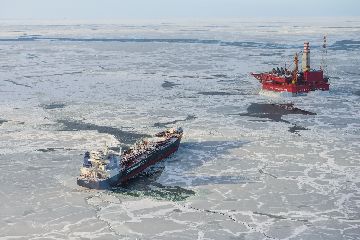 Gazpromburenie. In 2015, it is planned to drill 4 wells. The fall in world oil prices did not affect the pace of work at Prirazlomnaya in any way, and if everything goes according to the planned program, in 5 years the investment in the project worth 120 billion rubles will fully pay off. By 2018, the development of production will reach 4 million tons, by 2020 - 5.5 million tons. Then, a peak in the volume of average annual production of 6.6 million tons is possible, although now this task is not set. It is necessary to focus on scientific research in order to decide on the adjustment of the further mode of operation of the object.
Gazpromburenie. In 2015, it is planned to drill 4 wells. The fall in world oil prices did not affect the pace of work at Prirazlomnaya in any way, and if everything goes according to the planned program, in 5 years the investment in the project worth 120 billion rubles will fully pay off. By 2018, the development of production will reach 4 million tons, by 2020 - 5.5 million tons. Then, a peak in the volume of average annual production of 6.6 million tons is possible, although now this task is not set. It is necessary to focus on scientific research in order to decide on the adjustment of the further mode of operation of the object.
In general, 17 West Arctic deposits have been explored, and only 2 (Shtokman and Prirazlomnoye) are regarded as real potential for the future. Experts assign the role of "fellow travelers" to all others, and only after the information obtained as a result of their detailed exploration, as well as the first results of the development of the main fields, become known. The development of the Arctic shelf in terms of capital intensity is still unattractive, and due to the high cost of preparatory operations, the choice of options is limited. And there is no need to wait for investments comparable to the annual budgets of some countries; especially after the introduction of economic sanctions against the Russian Federation.
Impact of oil production on the ecology of the region
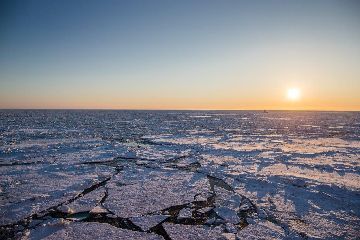 In the conditions of offshore production, an additional complication during operation is also increased environmental requirements. In this regard, the platform uses a number of progressive know-how.
In the conditions of offshore production, an additional complication during operation is also increased environmental requirements. In this regard, the platform uses a number of progressive know-how.
Inhibitors, which are relatively few in the technological process. This method is popular with Western companies due to its safety.
Sludge storage and transportation scheme that is isolated and easy to operate. The principle of "zero discharge" is observed, which excludes direct disposal of waste at sea. They are sent to a separate well designated for this purpose.
Containers, mercury lamps, batteries, together with possible excess sludge, are removed to the shore.
Unique valves specially designed for this platform, taking into account the specifics of operations in this region. So the risk of an accidental blowout is minimized by equipping the wells with a double protection system.
Even before the official launch of the facility, Greenpeace organized protests near the Prirazlomnaya platform. A particularly tense situation developed there in September 2013: the activities of the activists posed a threat to the safety of the service personnel. Subsequently emergency through forceful pressure and negotiations, it was resolved, and a criminal case was opened against the initiators of the action. According to statements management company no negative impact of the activities of oilmen on the natural environment is observed.
Until now, nothing is known about man-made accidents related to the operation of the mentioned platform.
There are not many unexplored regions left in the world. One of these places is the Arctic. The study of the Arctic began in the Middle Ages. The development of the region continues to this day. More than 2/3 of the world's Arctic offshore oil and gas fields are located in the Russian shelf zone. Prirazlomnoye is no exception.
History of the project
Geologists discovered the Prirazlomnoye field in 1989. The change of political regime and default prevented the development of the field.
It was only in 1993 that a subsidiary of Gazprom, Rosshelf, began to actively develop the Prirazlomnoye. Until 1994, geological exploration of three wells was carried out. Already in 1996, the company prepared a feasibility study. In 1997, a plan for the construction of a stationary platform was approved.
In 1998, when the design of the platform was at an active stage, the work was frozen due to an economic default. Five years later, the project was adjusted, and already a new subsidiary of Gazprom - Sevmorneftegaz - resumed construction. The platform installation time has been postponed for a long time. The first stage of construction was completed only at the end of 2010. And only at the end of 2013 it began to function fully.
Platform characteristics

The region where the Prirazlomnoye field is located is the Nefteyugansk region of the Nenets Autonomous Okrug. The platform is located 60 km from the mainland.
For the development of the field in the open sea, a specially designed platform was installed that can operate in conditions low temperatures, ice, strong gusts of wind and The depth at which oil production is carried out is 20 m. The platform is securely fixed on the sea bottom with the help of ballast. Its total weight, including ballast, is 500,000 tons. According to the plan, the platform is to drill 36 wells in order to provide an annual oil production of 6.5 million tons.
Field status

The Prirazlomnoye oil field is truly unique, since “black gold” is being extracted from the platform even in winter. However, the procedure for state registration of a structure by Russian legislation has not yet been developed.
According to Federal Law No. 187, the platform is an artificial structure in the continental shelf zone of the Russian Federation. In 2009, the Arbitration Court of the Moscow District made a decision to recognize it as a hydrotechnical stationary structure. Also in 2012 "Prirazlomnaya" was registered as a sea vessel in the ship register of Russia and assigned to the port of Naryan-Mar.
Management companies
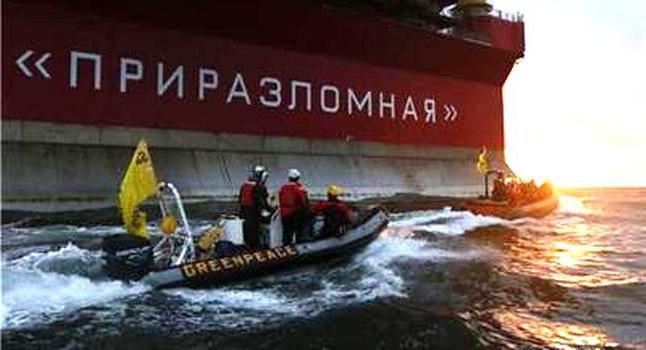
The Prirazlomnoye oil field began to be actively developed in 1992. It was in this year that a specialized enterprise "Rosshelf" was created. The constituent structure included about 20 different enterprises, some of them were engaged in geological exploration of the Shtokman field. In March 1993, Rosshelf CJSC received a license to carry out exploration, production and evaluation of oil deposits.
Since 2001, Gazprom and Rosneft have begun to develop the oil and gas basin of the Yamal-Nenets Autonomous District, including the Prirazlomnoye field. Yuganskneftegaz, a subsidiary of Rosneft, has been operating the platform pumping station since 2006. In 2002, Sevmorneftegaz received a license to use the Prirazlomnoye oil deposits. In 2009, Rosneft sold all of Sermorneftegaz's shares to Gazprom, and the enterprise was renamed Gazpromneftshelf. Since 2014, it has become a subsidiary of Gazpromneft.
Features of storage and transportation of oil
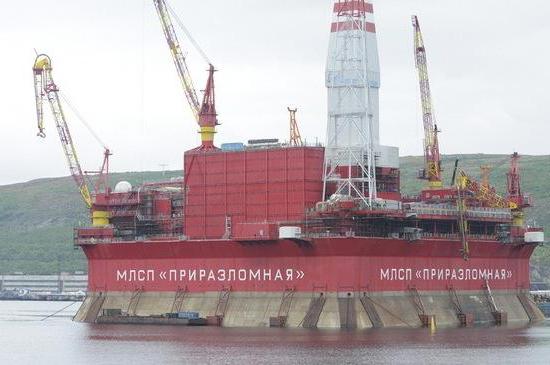
Reservoirs for produced oil are located at the bottom of the platform - in the caisson. The technology for storing raw materials in it is called "wet", because regardless of the filling of the tank with oil, it is always filled with water. Oil enters the reservoir using a diffuser mechanism. When filling the tanks, water is forced into the ballast system, which is further cleaned. The water is then used to pressurize the oil reservoirs.
To unload oil, water is poured into the tank from the pressure storage. The oil is pumped out from the surface of the tank to the offloading system. As it is pumped out, the ballast water fills the tank.
Transportation is carried out by shuttle tankers, which are moored to the platform without contact.
Environmental Protection Measures and Environmental Issues
The Prirazlomnoye field is located near several specially protected natural areas... Therefore, the environmental aspect of oil production is, as always, relevant.
Despite the fact that the project has passed a number of examinations, environmental damage is still being done. To minimize it, a number of measures are taken:
- devices are installed on the water intake pipes that can reduce the death of marine animals by almost 80%;
- torch operation at night is reduced as much as possible to avoid collisions of flying birds with the platform.
No oil field in the world is immune from raw material spills. The Prirazlomnoye field is being developed all year round, even during the polar night. liquidate quickly in arctic zone almost impossible - part of it goes under the ice. The spill response equipment is located almost 1000 km from Prirazlomnaya in Murmansk. Its transportation to the accident site is also difficult due to weather conditions.
The Prirazlomnoye field is a high-tech complex, where the most advanced methods of drilling, production and transportation of oil are collected. Its development is especially important for the Russian economy.
Sofia Zorina, Siberian Oil, No. 108, January-February 2014
The development of the Russian Arctic shelf began with the development of the Prirazlomnoye oil field. At the end of 2013, the first oil entered the storage facilities of the Prirazlomnaya offshore platform, a high-tech complex that contains the best developments in the field of drilling, production and transportation of liquid hydrocarbons.
The Prirazlomnoye oil field is located in the most explored part of the Russian Arctic shelf - the Barents Sea, or rather, in its southeastern shallow part - the Pechora Sea. The deposits here are a marine continuation of the huge Timan-Pechora oil and gas basin, which occupies most of the Komi Republic and the Nenets Autonomous Okrug. The sedimentary stratum of the Timan-Pechora, millions of years ago, which became the parent rock for future oil and gas deposits, is represented by Paleozoic and Mesozoic deposits, which reach Perm in the south, and extend far into the Barents Sea in the north.
The development of the continental Timan-Pechora began in the 18th century, when surface oil seeps were found on the banks of the Ukhta River. Since then, geologists have thoroughly studied these territories in search of hydrocarbon deposits. But they reached the shelf part of the oil and gas province only in the 80s of the last century. Prirazlomnoye was discovered in 1989, it is located 55 km north of the mainland and 980 km west of Murmansk. The depth of the sea within the field does not exceed 19–20 m. The structure of the deposit is a two-domed anticlinal fold extending to the northwest. Small faults (tectonic faults) oriented along the long axis of the fold are assumed throughout the area. The upper rocks are clays, underneath are oil-saturated layers separated by dense rocks. As for the Prirazlomnoye oil itself, it is low-sulfur, heavy and viscous, its characteristics are most similar to the Urals brand.
Law of the sea.
The shallow depths in the field area allowed the Prirazlomnaya platform to be installed directly on the seabed. As a result, the cluster of production wells was positioned so that with aquatic environment they had no direct contact. Thus, drilling on the platform is carried out in much the same way as on land. At the same time, at Prirazlomnaya, the offshore facilities increased requirements in the field of labor protection, industrial and environmental safety. In total, the platform has blanks for 40 wells: 19 production, 16 injection, one cuttings, and four more are reserve. From the very beginning of the field development, the priority method of increasing the production rate was chosen to build horizontal wells, therefore only one of the producing wells will be vertical, the rest will be horizontal, and two of them will be double-hole with a design oil production rate of 3300 cubic meters. m per day.
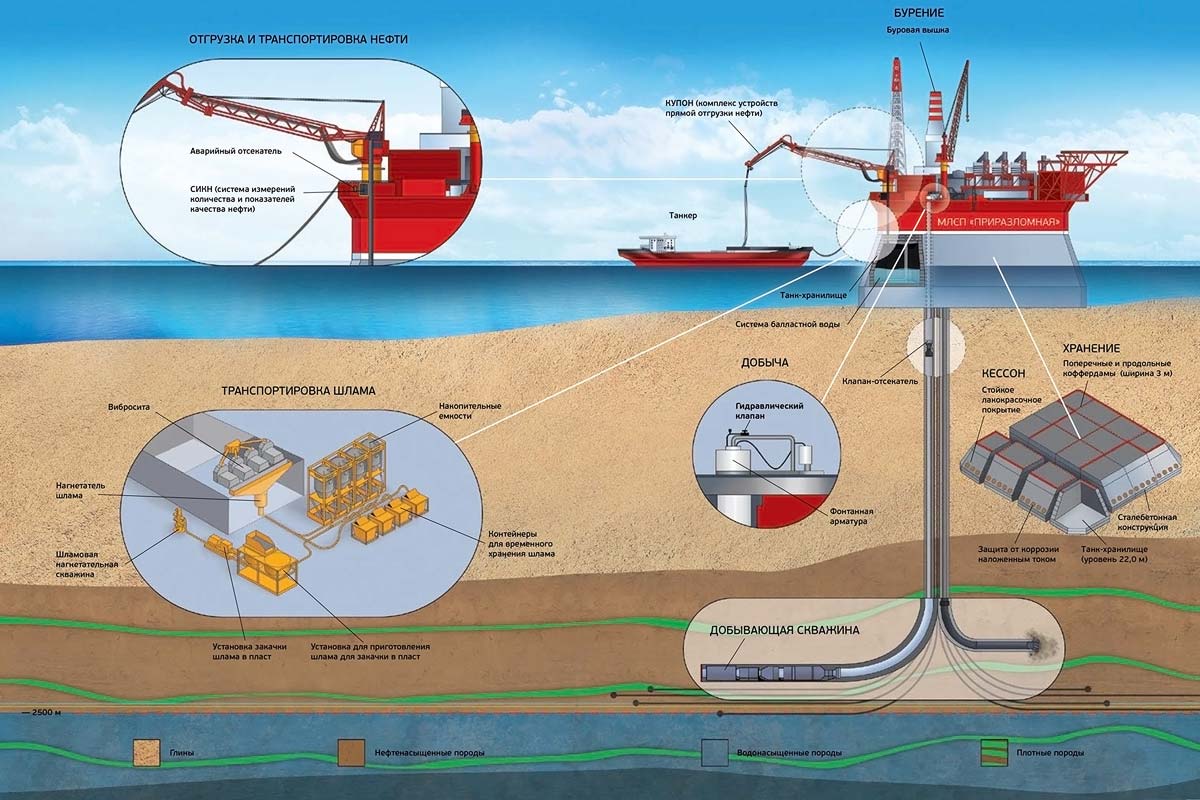
Drilling horizontal wells is already a rather complicated technological process, and in offshore conditions, increased environmental requirements become an aggravating factor. At Prirazlomnaya, a number of drilling problems have been resolved through the use of state-of-the-art highly inhibited drilling fluids. In particular, the Kla-Shield mud for drilling difficult, extended sections in the sections of active clays that make up the upper part of the field is also used onshore, but due to its high economic and environmental characteristics, it is widely used in offshore drilling. The mud strengthens the walls of the wellbore, while ensuring its effective cleaning, reduces the swelling of clay and its adhesion to the bit. The economic effect is achieved due to the fact that a relatively small amount of mortar is required to pass even long sections with active clays. The solution for opening the productive horizons was also carefully selected. The water-based drilling system in use has been successfully applied Western companies when drilling offshore due to its environmental friendliness.
A critical consideration in the design of the platform drilling was the choice of a system for storing and transporting cuttings - completely enclosed, easy to maintain. The "zero discharge" requirement at Prirazlomnaya does not allow discharge from the platform into environment nothing but water for fire extinguishing and treated domestic waste water. Used drilling mud, cuttings and other wastes are pumped into a special absorption well, and treated oil and oily water, contaminated rainwater and snow, collected by the drainage system, are pumped back into the formation. The rest of the waste (containers, mercury lamps, batteries, etc.) will be taken ashore, as well as excess sludge, if any.
Triple control.
It makes no sense to talk about the safety of an offshore production platform without assessing the risk of a gusher that may occur during the drilling or operation of wells. At Prirazlomnaya, it has been reduced to almost zero due to the installation at all wells of a double protection system against accidental emissions: a shut-off valve and a redundant hydraulic valve, which is part of the Christmas tree. This unique equipment was specially designed for the conditions of the Prirazlomnoye oil field and takes into account the specifics and special requirements for work in this particular region.
Onyx-5 (E) model shut-off valve is designed to cut off the lower part of the well in the event of an abnormal situation. It is installed at a depth of about 150 m from the wellhead. The hydraulic system connects the shut-off valve to the surface emergency stop system. As soon as the hydraulic equipment receives a signal from the safety system, the fluid pressure on the valve is stopped and it is automatically set to the closed position, thus isolating the well. All this takes place at a depth sufficient to ensure the safe operation of the well and the platform complex.
For safety reasons, the wellhead is closed with blowout equipment during drilling, and before production starts, it is replaced with a Christmas tree, including a remotely controlled hydraulic valve. This valve duplicates the functions of the shut-off valve in the event of a malfunction. The work of all these systems is tied to automated system management and security (ACSB).
In addition to the valves and gates described above, there is a third safety step - the Baker Oil Tools RCV ™ mechanical controlled borehole check valve, located at a depth of more than 2 thousand meters. It is installed in the well during the placement of the primary completion system to regulate the reservoir flow regime. When replacing an electric centrifugal pump or workover of a well, this valve shuts off the inflow from the reservoir, thereby preventing the loss of formation fluid. At the same time, it can also act as a shut-off valve, providing additional protection.
Ice class.
Obvious sources of risk are the processes of storage, shipping and transportation of oil. At Prirazlomnaya, the main storage hazards - leakage and the possibility of an explosion - are almost completely eliminated. The produced oil enters the lower part of the platform - a caisson with three-meter-thick walls and a double bottom, where the risk of explosion is eliminated due to the "wet" storage method, which excludes the ingress of oxygen into the oil storage. Ballast water used in wet storage maintains constant pressure in a tank with oil, thus ensuring not only 100% filling of the tank, but also back-pressure to the pumps involved in the shipment.

Shipping is the most vulnerable process, because this is where the oil leaves the impregnable caisson. However, the risks associated with shipment are also minimized to the utmost. Oil is pumped from the platform's storage facility to tankers using a set of direct oil offloading devices (COUPON) located on the platform. There are two such devices, which ensure an unimpeded approach of tankers to the platform in any weather and navigation conditions. To prevent oil spills during pumping, the offloading line is equipped with an emergency stop system that allows you to stop pumping raw materials within 7 seconds.
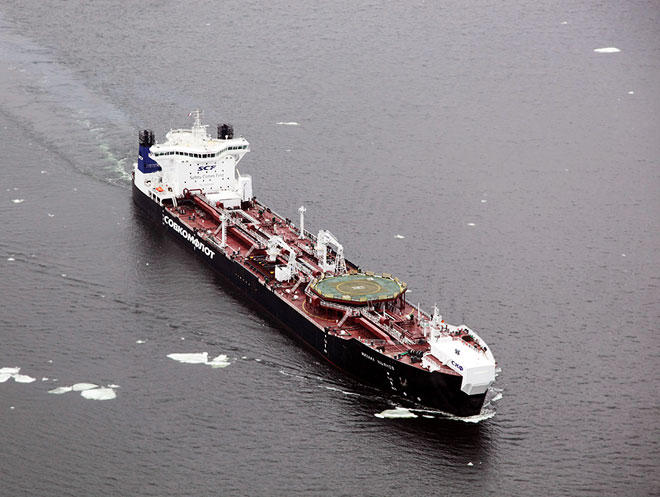
Before the start of unloading operations, shuttle tankers equipped with a bow loading system perform contactless mooring. The dynamic positioning system allows keeping the tanker in place, despite the wind and waves. Reinforced ice-class oil tankers with a double hull and a deadweight (permissible cargo weight) of 70 thousand tons - "Mikhail Ulyanov" and "Kirill Lavrov" were created specifically for operation at Prirazlomnoye.

These vessels are part of the marine transport and technological system (MTTS), which in turn is part of the Prirazlomnoye oil field development complex. In addition to Ulyanov and Lavrov, MTTS is made up of multifunctional icebreaking vessels (MFLS) Vladislav Strizhov and Yuri Topchev specially created for the project. The icebreakers were specially built by order of Gazprom Neft Shelf, which is developing the Prirazlomnoye field. The icebreaker fleet was recently reinforced with a third vessel, Vengeri, chartered from FEMCO. All icebreakers are designed to provide year-round platform maintenance, cargo delivery, and rescue duty. In addition, as auxiliary tugs, they assist in the offloading of oil to the tanker. The vessels are designed to operate in conditions of increased ice loads and are equipped with the latest complexes of emergency oil-gathering equipment designed to eliminate oil spills both in open water and in ice conditions. An additional support vessel was hired in accordance with the oil spill prevention and response plan in force under the project, as well as in connection with the start of the active phase of work: in December 2013, production began at the Prirazlomnoye field; in the first quarter of this year, the first oil consignments.
As the project develops, the system will also include port fleet vessels, a floating oil storage facility and line tankers. “Gazprom” is an outpost of Russia in the Arctic. Last year we conquered Yamal, creating on land in the Arctic latitudes unparalleled in the world new center gas production. Today they have become pioneers in the development of the Russian Arctic shelf. There is no doubt that Gazprom will continue to conquer the Arctic, "said Alexei Miller, Chairman of the Board of Gazprom.
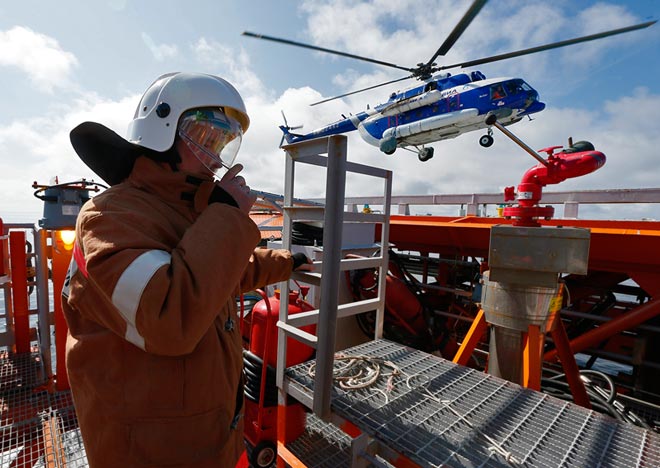
“The transport system of the project, which includes three multifunctional icebreaking ships and two shuttle tankers, allows full cycle works for uninterrupted supply and safe functioning of Prirazlomnaya. The vessels deliver cargo and personnel to the platform, ensure the technological and environmental safety of operations, and carry out year-round oil shipment and transportation. If necessary, they will assist in eliminating the consequences of accidents on the platform and possible oil spills in the platform's area of responsibility. In addition, recently, by order of the FEMCO company, the design and construction of the multifunctional icebreaker Aleut was started, which, as a vessel of a higher ice class and improved technical characteristics, in accordance with the obligations of the shipowner, in the fall of 2015, he will replace the Vengeri and begin rescue duty at the platform, ”says Gennady Lyubin, executive director of Gazprom Neft Shelf.
Prirazlomnoye oil field:
- opened in 1989;
- located on the shelf of the Pechora Sea, 60 km from the village. Varandey, Nenets Autonomous District;
- sea depth in the area of the deposit - 19–20 m;
- recoverable oil reserves - 71.96 million tons;
- design production level - about 6 million tons per year (to be provided after 2020);
- development period - 25 years;
- well stock - 36 pcs;
- productive horizons lie at a depth of 2.3–2.7 km.
"Wet" oil storage.
Oil storage tanks are located in the lower part of the platform - the caisson. Wet storage means that each tank is completely filled with liquid at all times, regardless of the amount of raw material. This is achieved through the ballast water system. So, in the filling mode, oil enters the tank from above through special devices called diffusers. During filling with oil, water is displaced from the tank into the ballast system. To avoid contamination of the ballast system with produced water, the latter is discharged into the treatment system and is further used to maintain pressure in the reservoir.
In the unloading mode, oil is displaced from the tank by water, which flows by gravity into the tank from the pressure tank. Simultaneously, a cargo pump pumps oil from the surface of the tank to the offloading system. As the pump draws off the marketable oil from the surface of the tank, ballast water enters the tank from the bottom through two sprinklers located at the bottom. Thus, it gradually replaces the oil in the tank.




